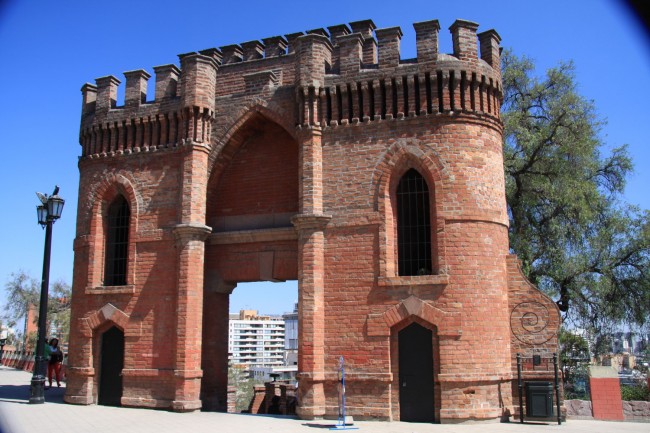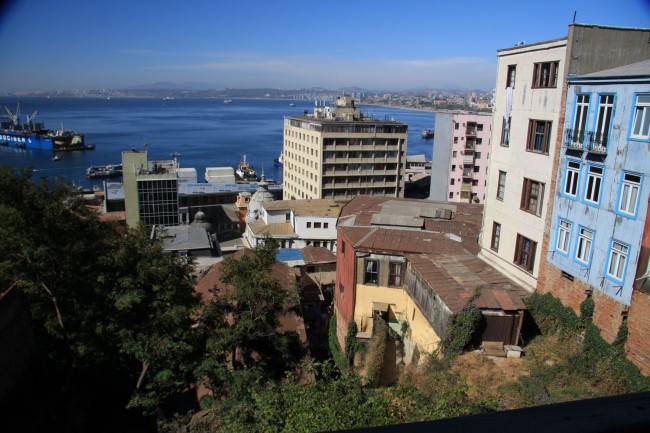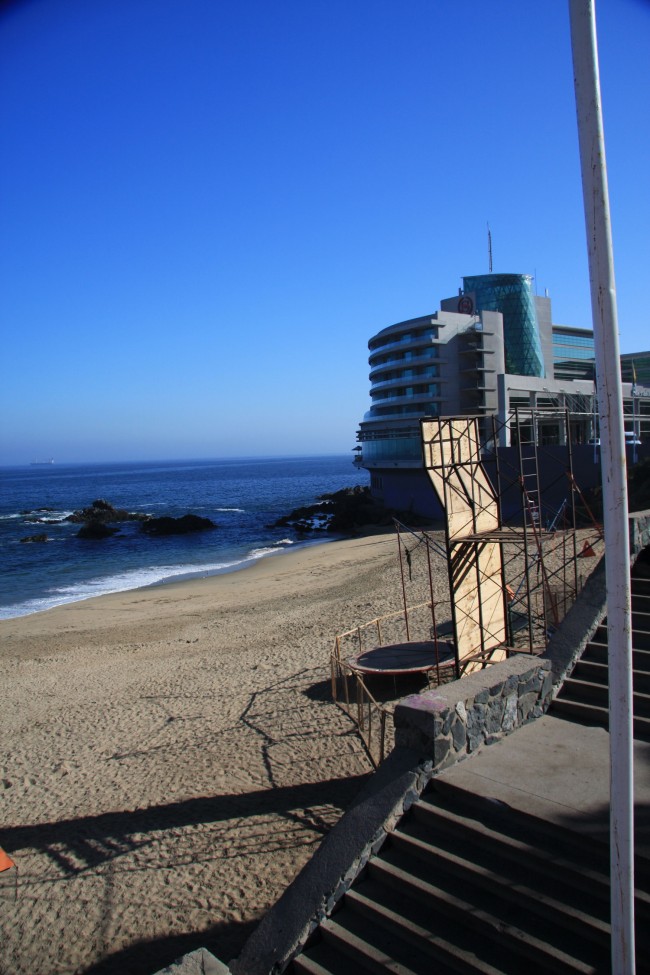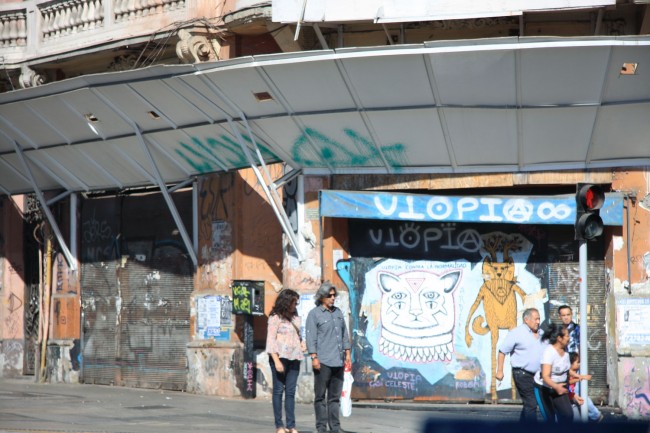April 13, 2014: Fanned by strong Pacific winds a wildfire has swept into Valparaiso, Chile.
Last week’s 8.2 magnitude earthquake in northern Chile reminded us of our own experience with earthquakes in central Chile a month ago and how they can alter man-made landscapes, especially in Chile, which holds the record for the strongest earthquake ever recorded, it came in at 9.5.
Plate tectonics makes all of Chile a hotbed of frequent seismic activity which can flatten entire regions as did the 8.8 magnitude earthquake of 2010 when it leveled central Chile. The 2010 earthquake resulted in over 400 deaths primarily from a tsunami generated by the quake. Last week’s earthquake claimed approximately a dozen individuals since the off shore seabed didn’t rupture generating the energy required for a tsunami.
Driving our rental car through the parched countryside on our 30 minute drive from the Comodoro Benitez International Airport to Chile’s capital, Santiago, we were struck by the absence of historic architecture, unusual for a city in this part of the world that was founded by the Spanish in 1541.
While other capital cities along South America’s west coast, such as Ecuador’s Quito, are chock-a-block with historic architecture dating back to the 1500s, Santiago is different. Scanning Santiago’s cityscape you notice the ancient church steeples are missing, filled instead by nondescript concrete high-rises.
On arrival to get an overview of the city we engaged Sergio Gamonal so that we could explore Santiago in greater depth later on our own.
“Santiago has suffered from so many earthquakes over the past five centuries that many of our historic buildings have either collapsed or were deemed unsafe and torn down”, said Sergio. “But in 2010 the municipal government decided to save what was left of its architectural heritage and began a four year program to restore older buildings that have been damaged by earthquakes.”
While travelling through Santiago, Sergio pointed out buildings which have been restored. The city’s beauty is found in its neighborhoods for Santiago is a city of very distinct neighborhoods, some working class, others leafy and a couple are funky and bohemian, reconstruction helps keep them intact.

All that remains of a Spanish fortress in built in Santiago during the 1700s after numerous earthquakes.
On our last day in Santiago we heard the coastal city of Valparaiso had been hit by a 5.5 magnitude earthquake that morning. This news created a bit of excitement as it happened to be the next stop on our Chilean itinerary. We cracked a few nervous jokes and knowing that earthquakes were common in Chile with tremors being felt practically daily, the news didn’t come as a total surprise, so we set out.
Once the richest port city in South America, Valparaiso’s fortunes sank when the Panama Canal opened in 1914 and shipping bypassed it. The infrastructure and architecture of this once wealthy city has decayed with time and neglect (although gentrification is occurring in three large pockets within the city). You need to hire a guide to ferret out this city’s architectural gems. In our case we hired Michael Arnold, a.k.a. The German Pirate. Fluent in English, Spanish and German his detailed knowledge of every street and house turned a dreary streetscape into one of vibrant beauty, if only in your mind’s eye.

The Valparaiso apartment buildings in the foreground were built on the side of a hill, on bed rock, during the late 1800s to early 1900s. The two spires in the middle of the photograph are commercial buildings built during the same time as the apartment buildings and again on bedrock at the foot of the hill. They all remain intact. While the modern buildings in the background are built on landfill and the original commercial buildings collapsed during earthquakes.
Initially puzzling is Valparaiso’s business district where magnificent historic buildings line the streets closer to the foot of the hills. The flatter areas nearest the shoreline are a mixture of historic buildings and ugly modern concrete high-rises. Clearly urban planning gone mad. But as Michael points out “the flatter areas closer to the shoreline are built on landfill which is soft, so when powerful earthquakes hit those buildings are more likely to collapse,” thus the mixture of historic and modern buildings in this quadrant.
However, the beautiful pre-1914 buildings in the business district built along the foot of the city’s many hills have foundations constructed on solid bedrock and most survive the numerous earthquakes intact.
Our last night in the coastal district was spent in the neighboring resort town of Vina del Mar where we stayed at the Sheraton Miramar Hotel. This hotel capitalizes on its very unique location. It is the only building in this entire region which extends out into the Pacific Ocean. Built on bedrock, and meeting Chile’s strict seismic building codes, its foundations are solid, which, as it turned out is a good thing, as we were to discover that night. Around 1:30 a.m. the first of two earthquakes struck. We awoke to the thunderous sound of windows ratting and the bed shaking, which seemed for an eternity. Suddenly it all stopped and an eerie silence descended.

Sheraton Miramar Hotel, Vina Del Mar, built on an outcropping of bedrock. We were woken up at 1.30 a.m. when the first of the two earthquakes struck.
Dozing off again, the second earthquake struck with the same force as the first one, or so it appeared. Once the room was still again we anticipate that we would hear commotion in the hallway as other guests may be coming out to investigate, so we stepped out. Nothing. Most of the hotel’s guests where Chilean, well versed in natural disasters, they instinctively felt that this one wasn’t worth getting out of bed for, so we simply returned to bed, as if nothing happened.
Written by Joseph and Diane Frey
Photo Credits
Damaged building – By Diane Frey – All Rights Reserved
Apartment buildings – By Joseph Frey – All Rights Reserved
Spanish fortress – By Diane Frey – All Rights Reserved
Sheraton Miramar Hotel – By Joseph Frey – All Rights Reserved



Please Share Your Thoughts - Leave A Comment!